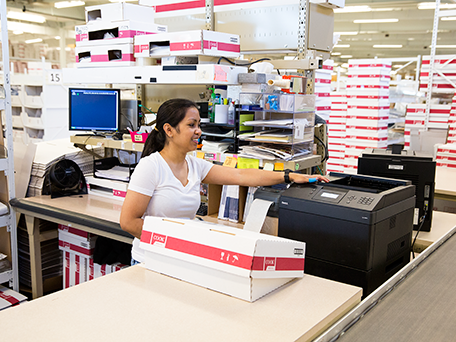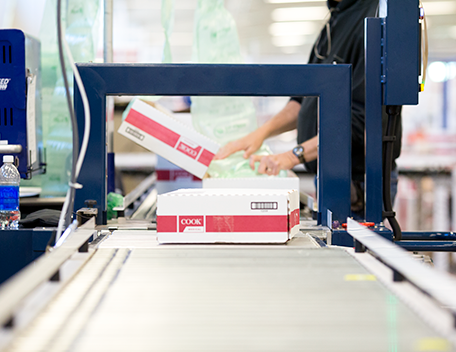The best supply chain is an invisible one. We experience an efficient and streamlined supply chain without even realizing it, every time we go to the grocery store. All the products, though they are made by multiple companies, scan easily and can be paid for together. That’s what we as consumers expect from our retail experience. That simple transaction takes a lot of coordination behind the scenes, and not every industry has reached that level of sophistication yet. Healthcare is one of those that still has some work to do.
In 2013, we were one of the first medical device companies to add a new barcode to all of our products. The barcode is a GS1 data standard made up of the following pieces of information:
This barcode, while principally acting as a new way to identify and track products, represents a significant change in healthcare. Historically, every device manufacturer created its own product numbering system and every customer created its own way to consume that data. Manufacturer and hospital IT systems did not speak the same language, which caused a lot of repetitive work and human error. This inefficiency spanned from billing systems to ordering and invoicing and costs the healthcare industry a huge amount of money. In fact, a 2012 McKinsey & Company report estimated that a minimum $40 billion dollars could be saved by global use of data standards in healthcare.
It’s a journey. It’s constantly changing, it’s constantly moving. We should all be in the room for the same reason: to improve patient safety. And along the way, we can cut healthcare costs. We can improve the supply chain.
— Chuck Franz, Chief Information Officer, Cook Medical
Fifteen years ago at Cook, we realized our IT systems were getting in the way of our ability to do business efficiently. The systems we used around the globe didn’t speak the same technical language, so it became difficult to coordinate how products moved around the world. Collecting that data was messy, inefficient, and expensive. Working through our own data conversion taught us a lot about how data standards can reform an organization.


The ability to track a medical device from a manufacturer’s warehouse to a patient’s bedside is vital to a cost-effective and safe healthcare system. Ideally it should be easy to find out where a product is at any given time. Currently, capturing data is time-consuming and prone to inaccuracies.
For example, a receiving clerk at a hospital might have to catalog what has arrived in a shipment box by box using pen and paper. A lot of this data is entered into an inventory system manually, which is prone to human error and inaccuracy.
Currently, healthcare providers also have to keep their own supplier account numbers. Their methods for doing so vary and each account has to be maintained regularly.
Using data standards, including global location numbers, would eliminate redundancies and make data capture simple and quick. More reliable tracking information would mean that, in the event of a product recall or a product transfer between hospitals, these products would be easy to find in the supply chain.
"The main current result of the GLN [Global Location Number] we are seeing is that the product is getting delivered to the correct location!"
–Kevin Capatch, Director Supply Chain Technology & Process Engineering at Geisinger Health System
Currently, product usage data is often captured using peel-off product labels that are stuck onto a patient’s paper record and then entered manually into the charge system. It’s easy to see how such a process could lend itself to inaccurate data collection. Sticky labels accidentally walk out the door of the OR on a clinician’s scrubs, or errors are made when a nurse spends the last two hours of her 10-hour shift manually entering product data.
Furthermore, the product usage data that is captured is not always reported back to those who are responsible for ordering supplies for the hospital. And managing inventory efficiently is difficult to do if product usage data is inaccurate or unavailable. Without knowing exactly what’s being used, it becomes easy to order more products than are really necessary.
Using data standards throughout healthcare IT systems would make these processes more efficient. A clinician would scan a product barcode at the patient’s bedside, and the electronic health record, billing system, and inventory systems would all be automatically updated.
And, if a provider is able to only order what product is really necessary, then we as a supplier can manufacture more efficiently. Everyone saves time and money, and less waste is created.
For us, using standards is principally about making patients safer—making sure the right product is delivered at the right time to the patient’s bedside.
— Dave Reed, Vice President, Healthcare Business Solutions, Cook Medical
Safety should always be top of mind for anyone who works in healthcare. Data standards can play a significant role in patient safety by ensuring that products that are recalled or expired are pulled from the supply chain before they can be used on patients. Today, the unfortunate reality is that there is little chance for product confirmation at the patient’s bedside. With a system that implemented data standards across its inventory and patient health systems, a quick scan of the product’s barcode before a procedure could ensure that the device was ok to use.
Data standards would also make notifying patients about a product recall significantly easier.
Today, this is horribly difficult given the sporadic data collection at the patient’s bedside. For example, if you are a patient who had an implanted device and heard on the news that thousands of similar products had been recalled, today it would take time for the healthcare system to let you know definitively if your device was affected. Using GS1 data standards across the industry would speed this process up significantly.

Perhaps the most forward-looking benefit of implementing data standards across our industry is the impact they could have on clinical outcomes. Using data standards equals collecting new information. As data about product usage, patient health records, and financial systems, etc., starts to build, hospital systems and healthcare providers can aggregate data and use it to make smart clinical solutions in the future.
For example, today it is possible to see the difference in price between two competitive products. However, the clinical outcomes associated with that product usage are not easy to determine. If one physician uses a slightly more expensive product, but his patients are rarely readmitted, while the more inexpensive product is used more often but with poorer clinical results, health systems can use that information to their advantage and reduce the overall cost of healthcare in their facilities.



No matter where your organization is on its journey to adopt data standards, we are interested in working with you. We support any organization that is willing to make the changes necessary in order to fully adopt data standards. Whether you are just beginning to think about adopting GS1 standards, or you’re already using GTINs in transactions with your suppliers, we want to hear about your experience.
Do you have questions about how to get started on implementing GS1? Or are you encountering any roadblocks during the transition? Implementation is a journey that we are on together. Let us know how we can help. Contact Scott Todd, our supply chain solutions manager, at Scott.Todd@CookMedical.com.